BISHOP’S
Lessons in Faith and Healing
Prominent faith leaders inspire students

Building a Strong Foundation
Future Stewards of Our Communities

Prominent faith leaders inspire students

Building a Strong Foundation
Future Stewards of Our Communities
A magazine for The Bishop’s School community
Winter/Spring 2023 • Vol. 20, No. 1
Credits
Editor Cathy Morrison
Assistant Editor Jen Jordan
Contributing Writers
Lori Boyle
Zach Jones ’01
Jen Jordan
Megan McCuistion
Cathy Morrison
Doug Peabody
Trisha J. Ratledge
Joe Tash
Jared Scott Tesler
Joey Yusunas ’00
Graphic Design Design Perspective, Inc.
Printer
Neyenesch Printers, Inc.
Contributing Photographers
Lori Boyle
Annie Denten
iStock Photo
Jen Jordan
Cathy Morrison
Dave Siccardi
Studio M Photography
The Bishop’s School
Head of School
Ron Kim
Chief Advancement Officer
Emily Hassig
Senior Director of Alumni Relations and Annual Giving
Lori Boyle
Bishop’s is published twice a year by The Bishop’s School.
We welcome your feedback. Please send story ideas to news@bishops.com or contact us at (858) 875-0790.
The Bishop’s School 7607 La Jolla Boulevard La Jolla, CA 92037-4799

Phone: (858) 459-4021
www.bishops.com
Mission Statement
Bishop’s is an Episcopal school that nurtures students of intellect and character to think independently, learn collaboratively, grow their sense of self and act with greater purpose.

Front Cover Photographer
Cathy Morrison
Back Cover Photographer
Studio M Photography
Front Cover:
Presiding Bishop of the Episcopal Church, The Most Rev. Michael Curry delivered an inspiring and uplifting homily at the All-School Christmas Chapel on Dec. 9, 2022.


What do we do if we have been harmed? How do we think about our collective future in troubled times? This past fall, The Bishop’s School was blessed to host two memorable guests who asked us to think deeply about these fundamental questions.

In October, we hosted Father Michael Lapsley, Anglican priest and Director of the Institute for Healing of Memories, who has devoted his life to social justice, beginning with his fight against apartheid in South Africa in the 1970s. Father Lapsley was severely injured by a letter bomb in 1990, and he shared with our community a story of pain, initial desire for vengeance, and then ultimately a path to restorative justice for those who, like himself, have been harmed. None of us is immune to pain and loss, whether at the hands of another person or something less tangible like COVID; we all embraced his guidance and inspiration for how we seek justice and offer forgiveness.
In December, the Most Reverend Michael Curry, Presiding Bishop of The Episcopal Church, offered the Christmas chapel sermon to our students, faculty and staff. Paraphrasing Langston Hughes, he encouraged all of us to “hold fast to dreams, for without dreams, life is like a bird with a broken wing. But with a dream, look out!”
The recurring theme in Bishop Curry’s work is that in a time when we are all challenged by divisiveness, acts of violence and hateful speech, we have strayed from our obligation to love each other. Curry reminds us that the way of love has the power to move us past all that we think separates us and brings us together.
You may wonder, as a school, why are we emphasizing themes of justice, integrity and love? One answer is that we are an Episcopal school, and these are guiding values. Another answer is that students today seek hope. Our research partner on student well-being shares that worries about the future are among the greatest concerns of young people. They wonder about the world that they will inherit, and one of our tasks as educators is to provide them with hope and a way forward. We know that our students will encounter ups and downs in their lives, now and in the future, and in these pages you will see that we have grieved the loss of beloved colleagues. We want students to experience these challenges with resilience and optimism.
We help our students through amazing speakers, a consistent message on our values, and an educational program that is without peer in San Diego. In these pages you will also see how we are reimagining our flagship sixth grade program that is responsive to incredible demand, delight in the achievements of one of our top water polo players, see how our students develop a mindset for service and develop a keen sense of how they can touch the lives of others. Thank you for reading and for all that you do to support this wonderful School.
Ron Kim Head of School
 By Trisha J. Ratledge
By Trisha J. Ratledge
For three days in October, Father Michael Lapsley and The Bishop’s School came together in community to listen, connect and reflect.

His presence is undeniable, the gentle and calming Anglican priest from South Africa who acknowledges and eases trauma for individuals around the world with his workshops and whose example has inspired generations to stand for justice in their own lives and in their communities.
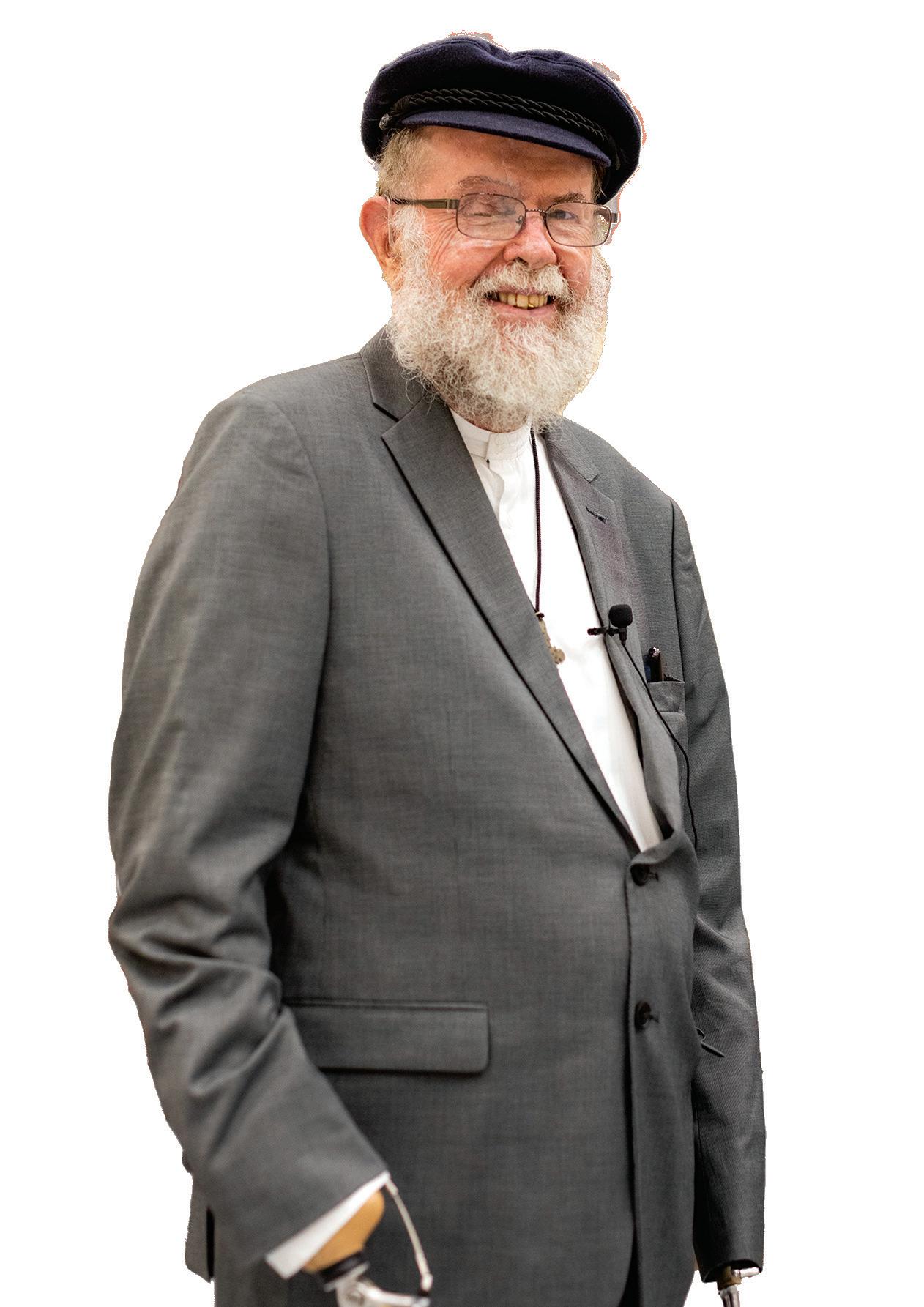
On Oct. 27, 2022, Father Michael Lapsley addressed students, staff and faculty at The Bishop’s School during an all-school chapel as part of a three-day visit to campus through the Endowed Leadership Lecture Series. One of the leading voices in the struggle against apartheid in South Africa, Father Lapsley’s sacrifices are evident. In April 1990, exiled from South Africa and living in Zimbabwe, he was opening his mail when he was blasted by a letter bomb hidden within the pages of a religious magazine. The bomb took his hands, an eye and shattered his eardrums,
but he tells audiences around the world that the blast left intact his most powerful weapon:
He has always used that voice freely and to its full effect against injustice.
“I often say, the day I arrived in South Africa I stopped being a human being and I became a white man because, suddenly, every single aspect of my life was decided by the color of my skin,” Father Lapsley told the Bishop’s community. “As a white person, I could enjoy the highest standard of living in the world. The only thing I had to do to enjoy the highest standard of living in the world was kill my conscience, my sense of right and wrong.”
Recovering from the letter bomb, Father Lapsley says he felt God’s presence by his side, along with the healing messages of love from people around the world. The pacifistturned-freedom-fighter became a healer, founded the Institute for Healing of Memories in 1998 and began running workshops globally where individuals can share their painful stories and heal in community with others.
 3 Lessons in Faith and Healing
3 Lessons in Faith and Healing
4 The Rev. Nicole Simopoulos-Pigato, Bishop’s chaplain, had seen the power of Father Lapsley’s workshops as an attendee in 1999 while a graduate student in South Africa. She invited Father Lapsley to come speak to the Bishop’s community and she organized his visit.
“My hope is that Bishop’s will be a place where we can tell our stories; where we can learn to listen to one another with reverence, respect and compassion; and where we can begin to heal the brokenness inside each of us and in this world we live in,” she told the audience in her introduction.
Father Lapsley’s visit coincides with the School’s focus on integrity—a core value exemplified fully in his life story— and the community welcomed him into classrooms and meeting rooms across campus. His messages during the chapel talk resonated throughout his visit, especially on the power to choose how one responds to adversity and the wounds of trauma.

“The question is not, ‘Can we avoid woundedness?’” he said.
“No, woundedness is part of the human journey. The question is, ‘How do we respond?’’ I want to suggest to you as young people that you can be the healers of one another. And I’m sure in many ways, you already are.”
“He showed people that you have to be tenacious in what you care about, fearless in what you care about, and that there’s no limit to what you can accomplish as a person,” says Ariadne Georgiou ’26, whose family also hosted a lunch with Father Lapsley, Rev. Simopoulos-Pigato and Head of School Ron Kim.
to talk about the history of apartheid, about why people would be so upset at someone fighting against apartheid that they would send a letter bomb. I’m a director but I’m also a dramaturg, which means I’m responsible for making sure that the actors understand the text.”
“I thought it was pretty cool that he talked about how theater was used as a form of activism in South Africa,” says Safina Abraham ’25, who met with Father Lapsley in a small session.
“The question is not, ‘Can we avoid woundedness?’” he said.
“No, woundedness is part of the human journey.

The question is, ‘How do we respond?’’
Several academic departments prepared students with lessons that would bring deeper meaning to Father Lapsley’s visit. Kristen Tregar’s theater students read “Master Harold”… and the Boys, a play by Athol Fugard depicting apartheid in 1950s South Africa.

“I wanted to find a way to connect Father Michael back to our curriculum,” Kristen says. “It gave us an opportunity
“That’s one of the reasons I like theater.”
In that same small session, Naveen Hernandez ’26 asked Father Lapsley to explain more about the process of the Healing of Memories workshops. “Reading the play gave me a better idea of how much of his work has had an impact,” Naveen says. “His perseverance is something to look up to.”
Under the direction of Christine Micu, choral music students prepared two South African songs to perform at the
chapel talk: Shosholoza, considered the unofficial anthem of South Africa, and Babethandaza, a song about honoring ancestors and marching in the light of God.

Choral student Riley Brunson ’25 asked Father Lapsley an especially poignant question during a small session. Still struggling with the loss of Bishop’s dance teacher Donna Cory, Riley asked Father Lapsley how he kept going and maintained his faith even when terrible things were happening to him.

“Seeing him still have such a deep faith in God was really inspiring,” Riley says. “He focused less on questioning, ‘Why did this happen?’ and instead on, ‘How can I react to it?’ What he said was really impactful to me, and it reassured what I felt deep in my heart that I needed to learn how to react to what happened and not keep questioning.”
“Father Michael was so kind and understanding and thoughtful in his response,” says Christine, who was present in the session. “For me, it was probably the most moving moment of
his visit, to talk about healing and his relationship with God and how he moved forward after something so terrible and having to go through the grief process.”
For David Moseley, religious studies teacher and Director of Global Education, Father Lapsley’s visit was inspirational on many levels. A native of England, he told his students that he protested against apartheid as a college student in the 1980s, a commitment that included getting arrested during a sit-in at an English bank that was invested in South Africa at the time.
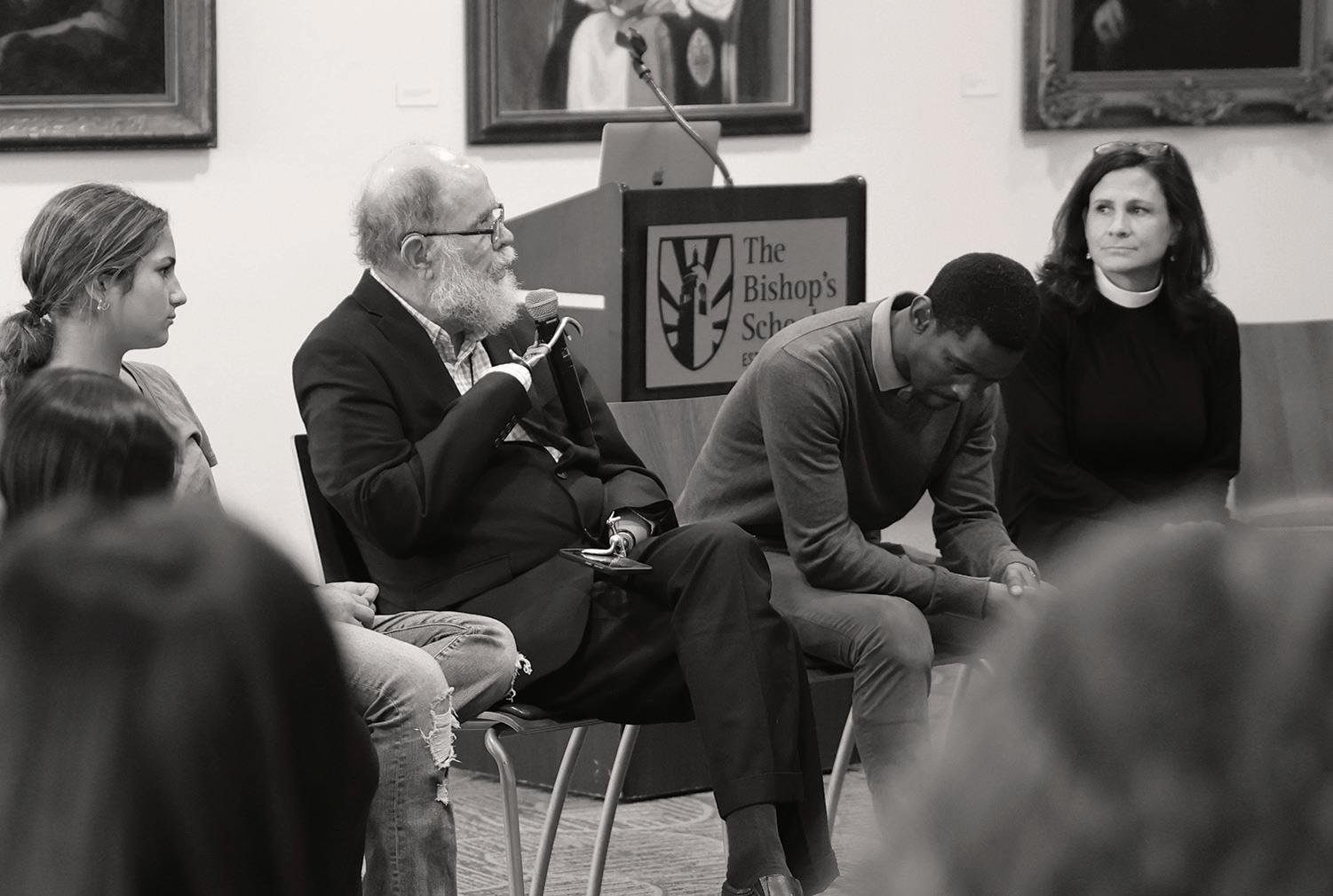
“Any opportunity for our students to hear from people who have lived in different parts of the world with very, very different experiences to ours is tremendously advantageous,” David says.
“Our kids are really lucky,” he adds. “I went to a good private school in England and we never had [any speakers] approaching these kinds of figures in terms of their political and economic influence and their moral power. Father Michael is a very powerful example of integrity.”
Henry Armstrong ’25 agrees that it is a special experience to meet and learn directly from people who lead extraordinary lives. “It means everything,” he says. “It’s not just reading from a textbook. It’s really connecting and getting to know them as people. Seeing Father Michael on campus and how he carried himself—and learning who he is as a person—is significant.”
“In chapel we’ve been talking about integrity as it relates to our identity. How do you live your most authentic life? How do you be who God created you to be in the world and use the gifts that God has given you?” says Rev. Simopoulos-Pigato.
“We’ve also been talking about integrity in the sense of standing up for what is right and just. And I thought about Father Michael. You can look at every chapter of his life and you can see that he has made choices that aligned with his values, his calling and what he believed to be right and good and true and just. I wanted the students to meet him and see him through that lens of integrity.”
As they pursue their academic studies, students at The Bishop’s School are also learning the importance of engaging with the larger community, both to ensure their voices are heard and allowing them to have a positive impact on the world around them.
Over the past several years— against the backdrop of increased polarization in the nation’s political life—the School has sought to provide students with the tools they need to become active, engaged citizens and how to treat each other with civility even when they disagree.
“We don’t have to agree but we do have to listen to each other,” says David Thompson Jr., the School’s Director of Diversity, Equity, Inclusion and Justice.
The goal was not only to foster civil dialogue on hot-button issues, but to impress upon students that their vote matters and how they can participate in civic life, whether at the local, state or national level.
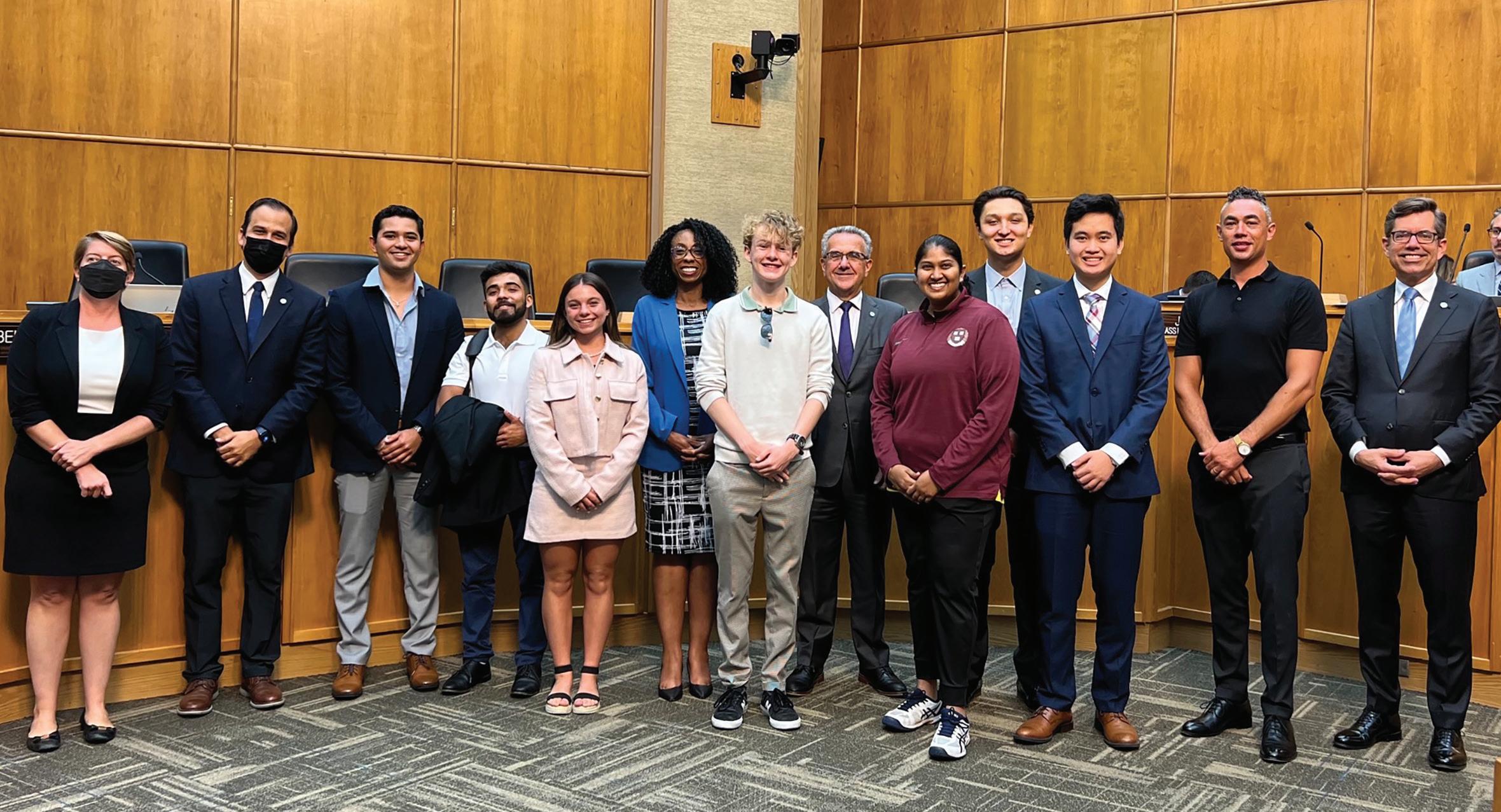
“We may have different approaches to how problems are solved, but we want to teach our students that we all have the same access and agency to have our voices heard,” David says.
At the schoolwide level, the effort has resulted in voter registration drives each of the past two years, as well as lessons on civic discourse and engagement. Across campus, individual students have found their own ways to get involved.
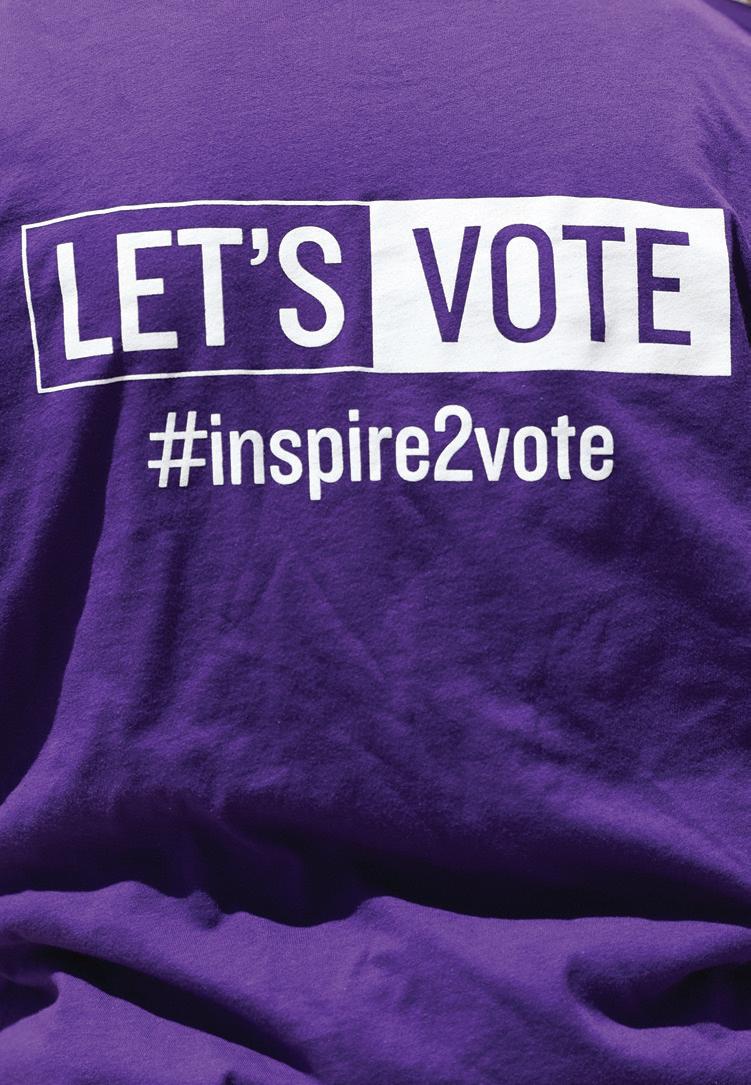
Among them is Marianna Pecora ’22, who led voter registration drives at Bishop’s and now, as a college freshman, works with Voters of Tomorrow, a national Gen Z-led youth advocacy group.
“I felt a need to get involved in civic engagement and politics because I saw an increasingly divisive and antagonistic attitude about our country and our government, both from politicians and from the people around me,” Marianna says. “I’m a strong believer in working
“Bishop’s is a smaller version of our national situation in that it combines different viewpoints and values discourse to help create a better community.”

have violated school rules and makes recommendations on appropriate consequences.
He also launched a nonprofit, Kid By Kid, that provides one-on-one tutoring for underserved learners, harnessing the energy of middle and high school students. Since the effort was moved online during the pandemic, the organization has tallied 10,000 hours of tutoring, and has taken root at 50 schools in seven states.
Daxton is convinced the efforts of himself and his fellow students makes a difference.
and make the world around us better.”
As a ninth-grader, she volunteered with the campaign of U.S. Rep. Scott Peters (CA-52), making calls and texts and knocking on doors. Through the experience, she learned about local issues that concern voters such as roads, infrastructure and neighborhood safety.
After that, she did an internship with the American Civil Liberties Union, where she worked on a campaign to create an immigrant legal defense fund and spoke before the county Board of Supervisors via video link.
to make conversations about our government as accessible and honest as possible for as many people as possible, and I thought starting with my own community at Bishop’s was a great way to do that.”
Another student deeply involved in civic affairs both on- and off-campus is Daxton Gutekunst ’23. The issues he’s most passionate about include a growing education gap, inadequate support for refugee populations and disappearing biodiversity.
“These are serious issues with deep roots. It would be easy to think that as youth, we cannot accomplish real change. I challenge that narrative. Not only can we make a difference, but we are the future stewards of our communities, and our voices need to be part of the dialogue and solution,” Daxton says.
Daxton serves on the San Diego Youth Commission, an advisory panel to the city’s mayor and council, as well as the Bishop’s Values Committee, which considers the cases of students who

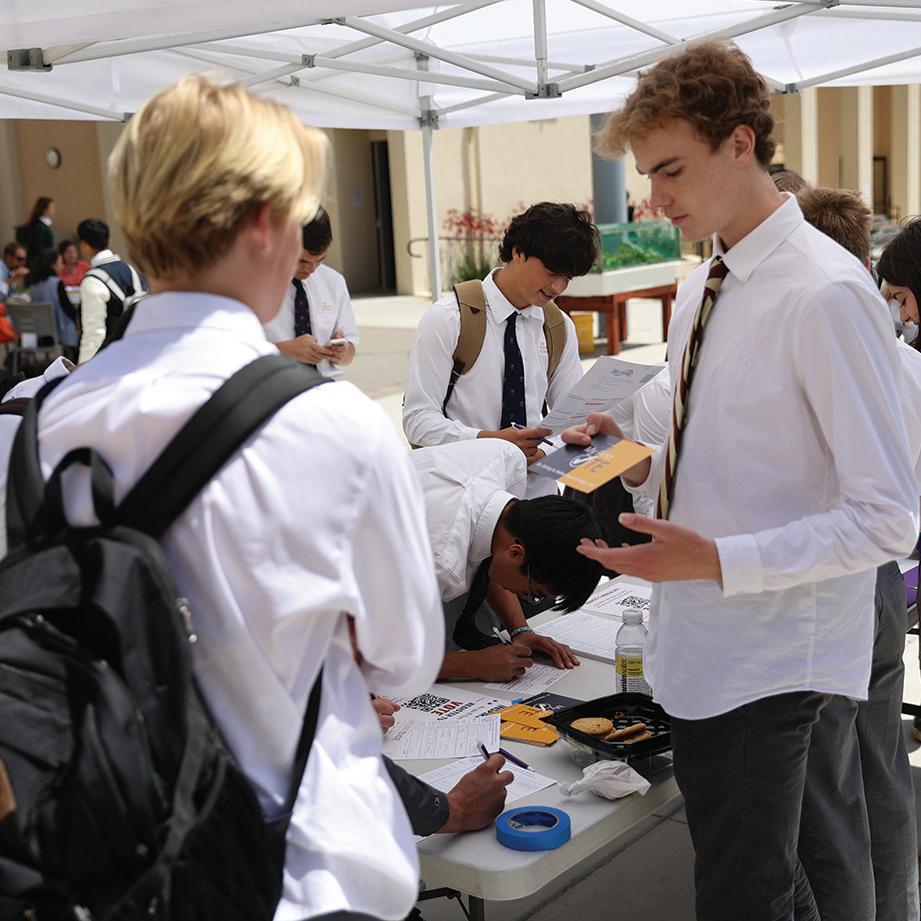
“Collectively, whether championing a specific cause or coming together to rally and raise our voices and concerns over inequities in our communities, youth is taking a center stage. More than in the past, I feel youth is taking a more active role in determining our futures,” he says.
For Annalise Chang ’23, civic engagement is a concept instilled both by her parents at home and by her school. She says it’s “the idea that we should give back to our community
“That’s a real empowering experience to see your representatives listening to you,” she says. A broad cross-section of groups supported the proposal, which the board approved. “I think a coalition of all our voices made this legislation possible.”
She also took on an internship with San Diego City Council President Sean Elo-Rivera, in which she is helping to build a database to keep the community connected and engaged with city issues.
She plans to major in political science or international relations in college, and urges her fellow students

8 to “find a cause you care about and continue to stay engaged.”
Will Keefe ’23 says civic engagement “is the opportunity and privilege of each and every American to be able to participate and advocate in our politics.”
For Will, that has meant working on voter registration drives with a group called Inspire2Vote, and volunteering with the campaign of U.S. Rep. Scott Peters. The work is important not only to encourage more young people to vote, but also to raise awareness about issues facing the nation, Will believes.
“The voters I register today are the policymakers and national electorate for our future. Everything about our political situation when I am an adult depends on the actions I take today, and is the reason I get involved,” Will says.
Bishop’s, which is educating the leaders of tomorrow, places a high value on engagement and participation in civic life, says Will. “Bishop’s is a smaller version of our national situation in that it combines different viewpoints and values discourse to help create a better community.”
“Civic engagement entails utilizing my own life experiences and education to improve the communities that I hold dear to me. It’s important to give back to the community I grew up in. As a youth, I have the power to increase determination and empowerment with my community, and act as a model for those younger than me to continue the work.”
Natasha Mar ’23 was inspired to give back to the community at an early age, led by her mother’s engagement with San Diego’s Thai community. During the 2020 census, she organized an event at the local Thai temple to teach recent immigrants about the importance of the
count and how to fill out the forms.
She’s also worked with groups seeking to empower and engage under-represented voters in the AsianAmerican community.
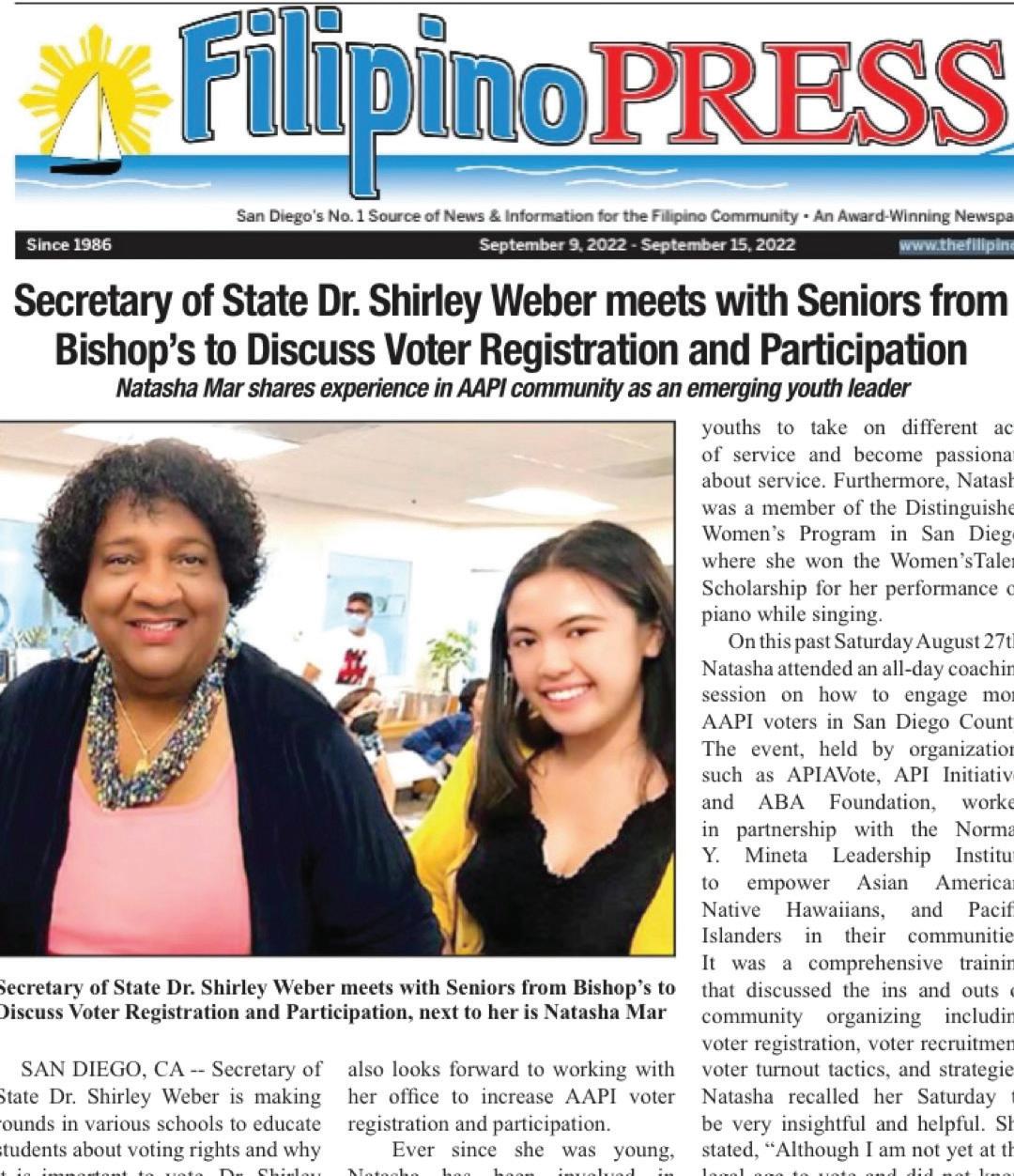
“Civic engagement entails utilizing my own life experiences and education to improve the communities that I hold dear to me. It’s important to give back to the community I grew up in. As a youth, I have the power to increase determination and empowerment with my community, and act as a model for those younger than me to continue the work,” Natasha says.
David says today’s youth are the most civically engaged generation in recent memory, and he’s encouraged by the level of participation in voter registration drives and other campus activities.
“They’re informed, they are curious about the world and interested in other people. They are more diverse, more connected and they have a stake [in the nation’s political life]. We want to give them the tools to exercise their voices for that stake,” he says.

On Aug. 7, 2022, the Bishop’s community lost a friend, colleague, parent, avid Knights fan and champion of all things Bishop’s. Bishop’s Director of Marketing and Communications Keri Peckham died peacefully as a result of complications of colon cancer. She was comforted in the knowledge that her husband Chase, and children Clay ’26 and Avery ’28, are loved and cared for by this community she so cherished.

In his eulogy for Keri, Head of School Ron Kim remembers, “Always during difficult times, she was providing what others needed—she was so good at translating emotions and pain into a clear message that was reassuring and honest. She often talked about the good relationships she had with so many people at Bishop’s, and her hope that everyone would have that same strong connection to this community.”
Prior to joining the Bishop’s Admin team, Keri was a consultant for Sterling Communications, worked as director of marketing for Quant Economics and served as a marketing and communications professional for the Rady School of Management at UC San Diego. In recent years, she started a blog and related Instagram account called “Time is Money Mom.” In her 20s, Keri served as a public information specialist for the Board of Governors Federal Reserve System. She held a Master of Arts degree in public communication from American University and earned her BA in public relations at Florida State University. She was a proud supporter of FSU football.

Keri was inspired by another member of “the cancer community,” author Kate Bowler, whose quote “Life is so beautiful. Life is so hard.” became a mantra of sorts, to which Keri added: “Family is everything.”

As we honor and remember Keri, we also resolve to help build colon cancer awareness and continue her support of this cause.
Performing arts and dance teacher Donna Cory died on Sept. 26, 2022. Her philosophy was: “Once you’re in the dance program at Bishop’s, you’re always in the dance program at Bishop’s.”
Over the course of her 20-year tenure here, alumni appeared in her dance studio twice a month on average. Some stopped by for a quick visit, chat or to give a demonstration; some were embedded with the Performing Dance Group (PDG) as a choreographer for a semester. Donna was fond of saying, “They have gone off to college and done something with dance. They have danced past us so they have information they can bring back to us.”
Donna was all about keeping the PDG students and alumni connected. “We could do the program without them,” she once said, “But it wouldn’t be as good. I don’t have time to teach and be researching exactly what is going on at UC Irvine’s dance program, which is amazing; beyond that, I can’t tell you the intricate, current details. But there’s a PDGer out there somewhere who knows that.”
She also connected PDG students and alumni through her annual spring break trip to New York City where the last night ritual was to gather at Sardi’s for a late dinner.
On Dec. 10, many of those PDG alumni and their families, along with former and retired faculty returned to campus for a Celebration of Life memorial service, joining Donna’s current colleagues, students and their families in sharing memories, music and dance pieces. In his remarks, Ron Kim said, “Welcome to all of you who knew and loved our beloved teacher and colleague Donna Cory. In my last communication with Donna, she asked that we not forget her. We shall not. We have come here today to remember her before God; to give thanks for her life; and to comfort one another in our grief. I thank you all for being here for her and for each other.”
Keri Peckham Donna Cory 9 Remembering Keri Peckham and Donna CoryOur fourth Woltman Family Lecture Series speaker since the program was established in 2018, The Most Rev. Michael Curry is a well-known spiritual leader in the public realm. He was the officiant at the funerals of President George H.W. Bush and Senator John McCain, and gave the sermon at the royal wedding of Prince Harry and Megan Markle. At Bishop’s he delivered an uplifting and inspiring homily during our all-school Christmas chapel and answered students’ questions afterward.
By Cathy Morrison
The Bishop of the Episcopal Diocese of San Diego, The Rt. Rev. Dr. Susan Brown Snook, introduced Presiding Bishop of the Episcopal Church The Most Rev. Michael Curry at the all-school Christmas chapel on Dec. 9, noting he has received “international acclaim for preaching and teaching with enthusiastic joy in the Gospel.”
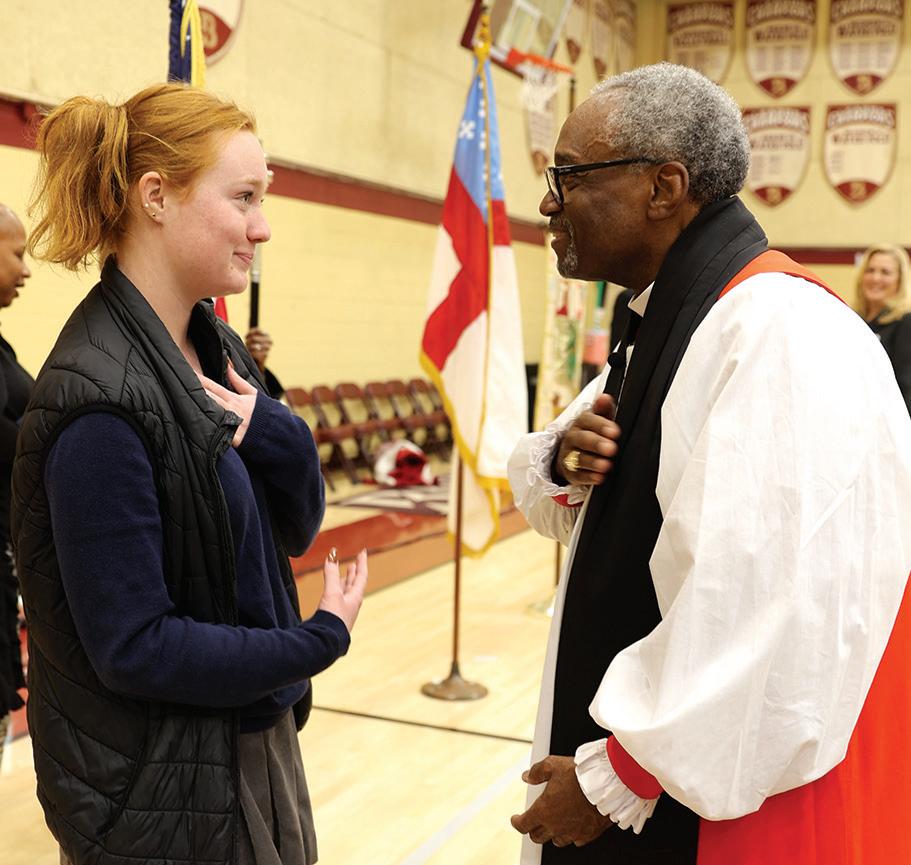
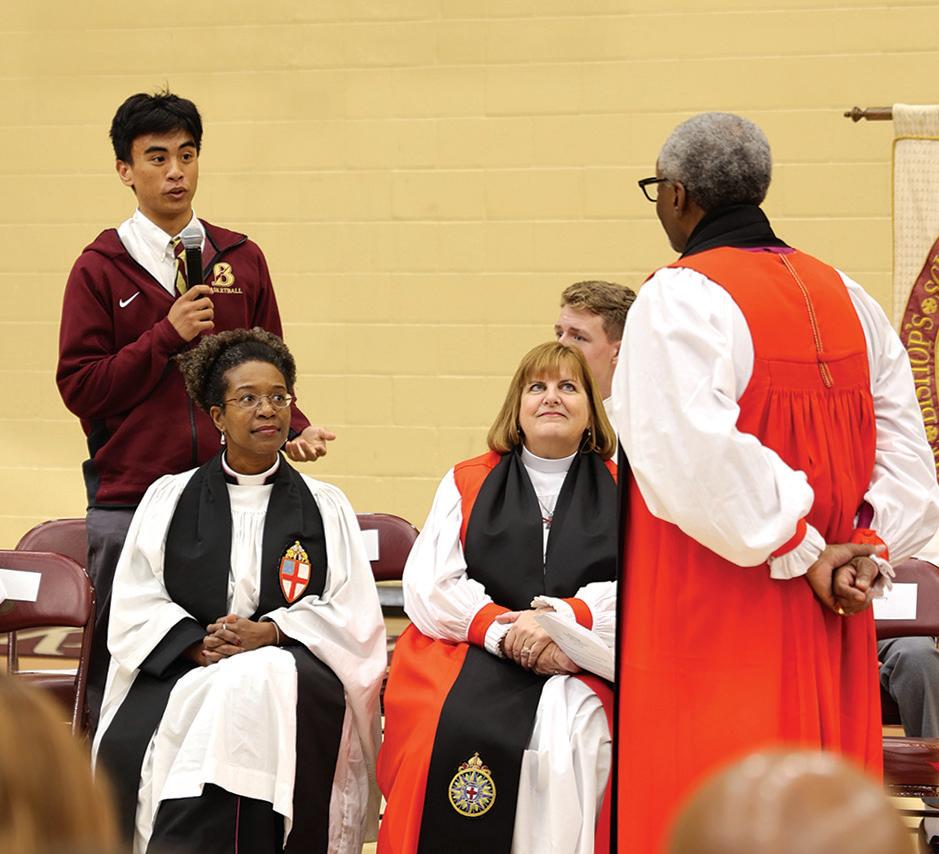
 Link to Bishop Curry’s official biography
Link to Bishop Curry’s official biography
That joy was evident in his countenance and his voice from the moment he stepped onto campus and throughout his presence during chapel.
He opens his homily by sharing Langston Hughes’ poem “Dreams,” describing how he’d learned it in elementary school. He returned to the opening stanza throughout his remarks, encouraging those gathered in the gym to “hold fast to dreams,” paraphrasing, “for life without dreams is like a bird with a broken wing that cannot fly.”
He adds, “It’s probably not an accident that the metaphor of dreams pops up when the world seems to be in turmoil,” reminding the community of biblical stories that demonstrate the importance and impact of dreams, from Joseph and his brothers—sons of Jacob—in the Old Testament to the story of Jesus’ birth in the Gospel of Matthew, when “people were dreaming all over the place!”
democracy…a time when Black, White, Coloured, Asian, Jew, Muslim, Christian —were all separated and segregated. Injustice was the order of the day.”
Hold fast to dreams
He remembers, “When Tutu spoke that day, when his world was falling apart, when he didn’t know if his country would ever find freedom, what I remember was how he ended his speech. He ended by saying, ‘I believe that one day, my beloved South Africa will be free… free for all God’s children! I believe that because I believe God has a dream for South Africa and nothing can stop God’s dream…God has a dream, a dream for this world, a dream for YOU. God has a dream for US.’”
For if dreams die Life is a broken-winged bird That cannot fly.
Hold fast to dreams For when dreams go Life is a barren field Frozen with snow.
exactly what I saw reflected in his words. So when I heard that he was coming to Bishop’s I was overjoyed and excited to hear more of his wisdom. I couldn’t help but ask for a selfie to commemorate it!”
Bishop Curry is a descendant of African slaves, whose father was also an Espiscopal priest. His grandmother was a Baptist; answering a question from Shea Rueda ’23, he describes his spirituality as “a fusion,’’ playfully noting that he and his sister spent summers with their grandmother, so “we were Baptists in the summer and Episcopalians in the winter.” However, one of the biggest pieces of advice he took from his grandmother was, “Don’t ever make fun of anyone’s religion, because that’s their path to God. You have to respect that.”
Bishop Curry explains, “When folks find themselves on the edge, when the world just does not seem to be the way it ought to be, that’s when, in the Bible, all of a sudden people start having these dreams. It may or may not be like the dreams we have when we go to sleep. When the Bible talks about those kinds of dreams, it’s talking about their deepest hopes. Their fondest aspirations, what they hope their lives and the world could be like. Dreams. Life without dreams is like a bird with a broken wing. But with a dream, look out!”
He includes a modern-world example of such dreams, talking about meeting Archbishop Desmond Tutu in the 1980s. Bishop Curry describes a time of great tumult, saying, “It was a time when no one knew if South Africa would become a racial bloodbath or a pluralistic
It took an entire year for The Rev. Nicole Simopoulos-Pigato’s dream of having Bishop Curry visit our campus to come to fruition. She says, “I learned that he was coming to the Episcopal Diocese of San Diego in December 2021. I started asking Bishop Susan then and subsequently worked with the Diocese of San Diego and Bishop Curry’s executive assistant to include a visit to Bishop’s in his schedule.”
Although she had never met Bishop Curry prior to this visit, she has read most of his books and listens to his sermons whenever she can. Once the date was confirmed, she began preparing students to meet him by having them do the same. Prior to the Christmas chapel, Rev. Simopoulos-Pigato gave a chapel talk about Bishop Curry and his family history, and played the last few minutes of a sermon he gave at Washington National Cathedral.

Junior Emma Madany shares, “I first learned of Bishop Curry in the first semester of sophomore year, when Dr. Ballard showed us a sermon of his in class. What my faith means to me is unconditional love, and that value is
Ryan O’Donovan ’27 asks, “In your book, you write about growing up in a Christian faith. When and how did you decide to make this faith your own?”
Bishop Curry responds, “I was in college before I came to think about my faith more deeply. I wanted to do something that mattered. And then I realized that I had grown up in a faith that could make a difference. I was an economics major but I took a course in prophetic religions and started reading the writings of Dr. King. Not just the famous speeches, but the actual writing, and I said, ‘You know, there’s something here, because of his faith.’ Desmond Tutu? He did what he did because of his faith. I’m 69 years old and I’m still at it, and as Maya Angelou says, ‘I wouldn’t take nothin’ from a journey now.’”
 By Megan McCuistion
By Megan McCuistion
Bishop’s sixth-graders traditionally have a smoother transition to seventh grade, already familiar with the program and schedule. From the unique curriculum to breaks between classes to interactive learning experiences, newcomers in seventh grade are taking in what life at Bishop’s feels like, getting familiar with a new school and making new friends.
This fall, the sixth-grade class at Bishop’s will expand to 80 students, allowing for more pupils to easily make the transition to seventh grade already familiar with the traditions and practices of the School.
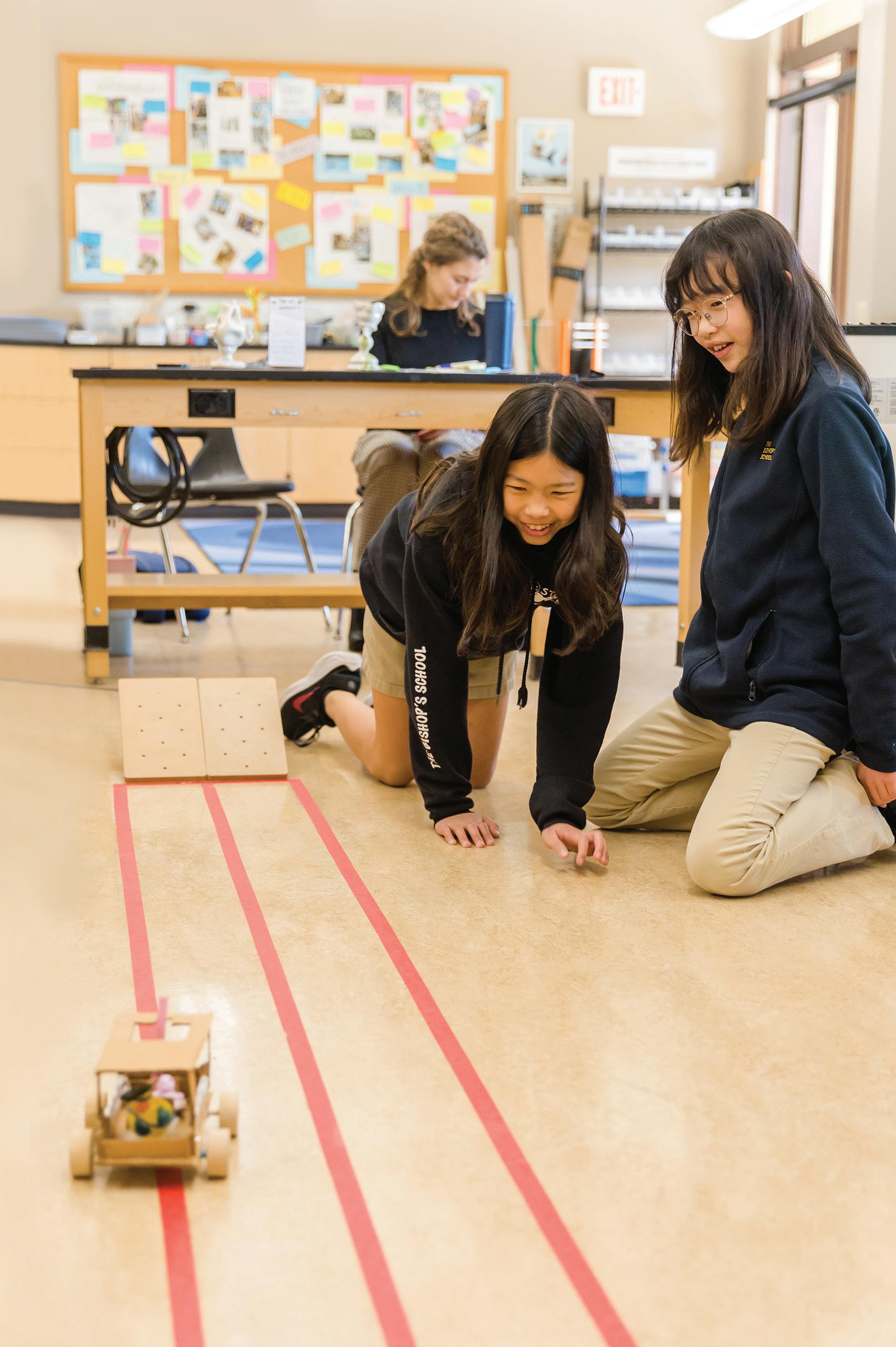
“We have been getting amazing applicants and it was hard to turn so many away. We thought about how nice it would be to be able to offer it to more students who would then get to develop some of those important skills,” says Jasmyn Tanner ’98, who serves as Associate Dean of Students for Middle School and Sixth Grade Advisor. “It will be nice for the sixth graders to move on to seventh grade together and continue forming those friendships, bonds and relationships with teachers. They will really be able to understand our values and have a better sense of what it means to be Bishop’s students.”
So, what makes sixth grade at The Bishop’s School so special? When sixth
Going from elementary school to middle school can feel like a big jump. In addition to a more advanced curriculum, students balance rotating classes, setting up their schedules and working with multiple teachers for the first time.grade was added in 2009, School administration focused on four pillars that set the experience apart from the traditional sixth grade.
For the sixth-grade team, their individual identity is that of a sixthgrade teacher, rather than grouping with their subject area. Their focus is entirely on the sixth-grade experience and the learning and developmental needs distinct to that age group. Sixth grade students have the opportunity to get to know their teachers and see them function as a highly effective team working toward the same goals.
“Our sixth-grade team gains so much, not just professionally from the collaboration, but personally as well. That collaboration leads to benefits like a holistic and integrated approach to the curriculum, a consistent and clear set of expectations and a deeper understanding of the personalized needs of individual students,” says Brian Ogden, Assistant Head of School for Academics and Curriculum. “This team is so high functioning because of the close relationships and the trust that they build with one another in service to their students.”
Much of the time in the sixth-grade wing is dedicated to building belonging and teaching important life values and skills. Each teacher serves as an advisor to a small group of students, becoming a leader, confidant and mentor. Every sixth grader is known, looked out for and
supported by an entire team of adults throughout their time at Bishop’s. Time before, between and after classes is spent together, connecting through their learning experiences and ties outside of school.
“I get to work with students in any capacity that involves their well-being. I check in on student behavior and talk through various issues with students. I try to make sure their experiences are as amazing as they can be and make sure that the interactions they are having on campus are positive ones,” Jasmyn says. “As an advisor, I keep a close eye on the 13 girls I work with, but I also do that for all the students that I’m connected to.”
The sixth-grade learning experience is a vastly different one than traditional middle schools provide. Students are exposed to subject choices and rotations in arts and languages, building a curriculum that is designed through freedom and agency. These class choices create high engagement, hands-on learning and real-life relevance while allowing for flexibility and spontaneity. Each year a school value is integrated into the curriculum, making interdisciplinary connections and teaching students to relate their knowledge to the world around them.

“Our goal is to introduce students to a wide variety of topics and ideas and help them navigate a new world,” says Laura Cummings, sixth grade science teacher and science department chair. “We find out what sparks their curiosity and interest. We are teaching a new way to approach questions and problems and helping them learn foundational skills that they will use throughout their lives.”
With a designated sixth grade area, team members use their close quarters to easily communicate, observe and collaborate. The students have a place to call their own, creating a convenient and effortless place to cultivate their community.
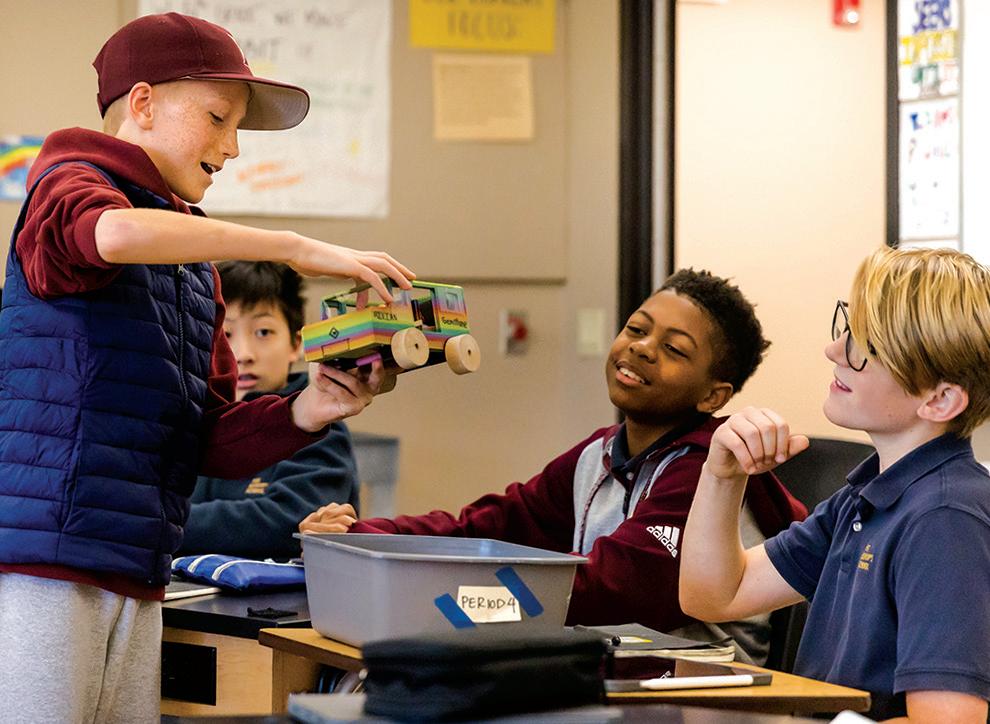
“Sixth grade is unique because they are very close to one another. They’re not spread out on the campus, so they get a lot of time to get to know each other,” Jasmyn says. “The way we design our well-being time—the way that we design any time together—is really about how our students can form these relationships that are going to last all the way through.”
With an education outlined by these four pillars, sixth grade students at The Bishop’s School are learning everything they need to have a successful tenure as a Knight and move forward for success beyond the middle and high school classrooms.
“Sixth grade is an important foundational moment for students. As a program, we want to introduce these students to all things Bishop’s. In a scaffolded way we build up to the expectations Bishop’s has for students,” Laura says. “We’re helping them learn to become middle schoolers and who they want to be. Students who go through our sixth-grade program are more fluent in how things go at Bishop’s and they have the habits they need to be successful. By expanding, we will be able to have all seventh graders on the same page.”
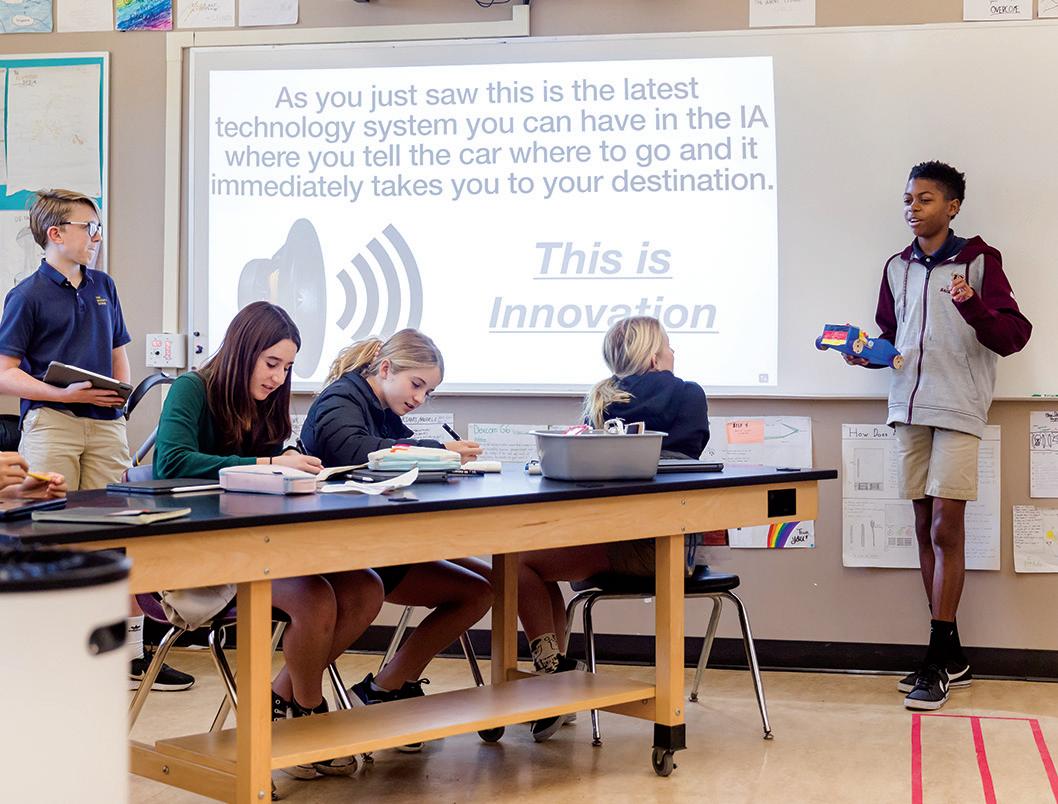
 By Zach Jones ’01
By Zach Jones ’01
From the outside, it looks nearly automatic—a foregone conclusion, even. Five straight CIF championships in girls’ water polo and now a dozen banners in the last 13 years. This year’s title march made one of the country’s most competitive water polo divisions look singularly uncompetitive, with a 51-15 scoring differential over three postseason games—an average winning margin of 13 goals per game against the best teams San Diego could offer.
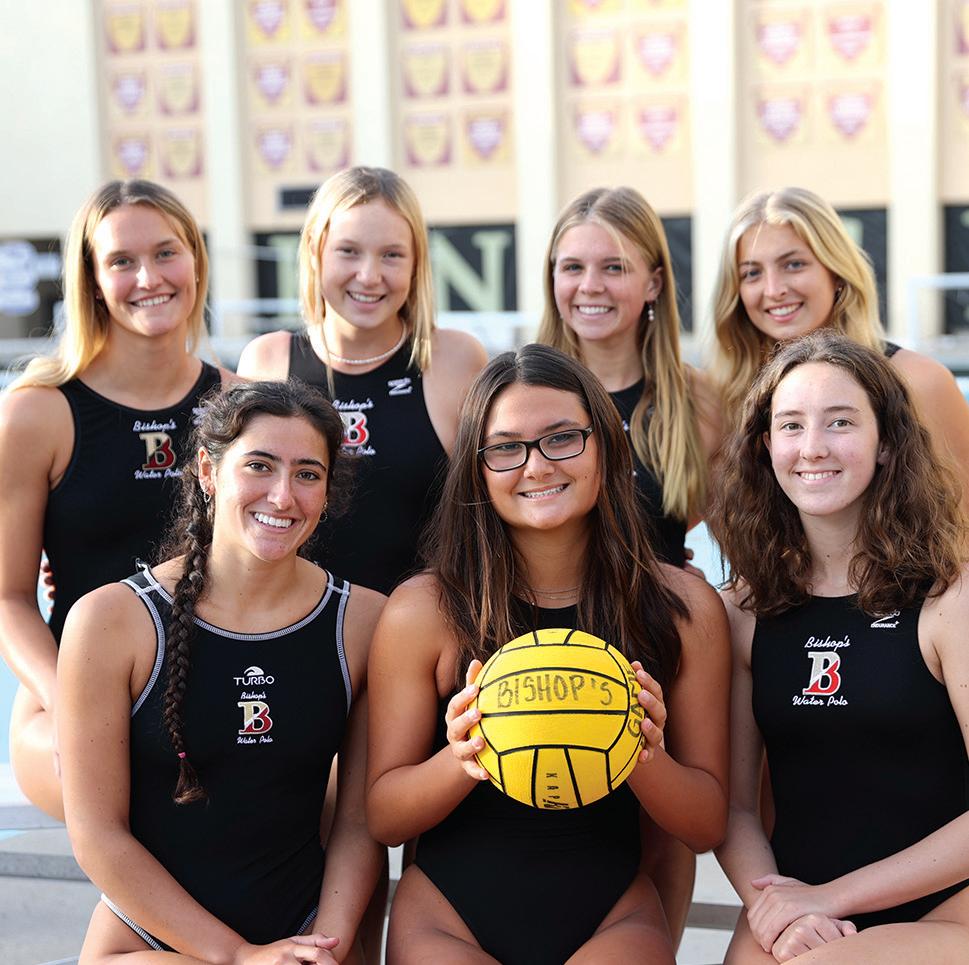

Only once during head coach Doug Peabody’s tenure have the Knights failed to reach the CIF title game, so you’ll pardon the casual observer from merely seeing a championship team on repeat.
But that word—“team”— misses the magic behind more than a decade of dominance, and there’s a reason you don’t hear it much from those who have actually done the winning.
“I wouldn’t say it’s a team. I would say it’s a program,” says first-year coach Georgia Gilmore ’17, who would know as well as anyone after a Bishop’s career that featured four championships. “Every year, you’re playing to help develop the next year as well. You’re preparing the player who’s coming next to work just as hard as you are. That’s just as important to your development as a young woman as it is [as] an athlete.”
That approach was especially crucial this season, as the Knights looked to replace six departed seniors, three of them starters and five All-CIF honorees, including two-time CIF Player of the Year Maggie Johnson ’22. To continue the championship streak in 2023 required not only replacing that group’s prodigious scoring output, but hundreds of games of combined experience.
But in a program that is always planning for what comes next, those challenges presented themselves as a chance to reinvent the juggernaut once again.

“Our expectation was a fresh and clean slate with a lot of girls who had been waiting in the wings to have their opportunities to be starters in this program,” Peabody says. Seniors Chiara Marmanillo and Julia Bonaguidi were his sole returning starters this winter, and each faced new demands on this less experienced roster.
Marmanillo’s status as a two-year starting goalie already positioned her as a team leader, but the departure of so many veterans put a finer point on those demands.
“This year I was looking to step into that leadership role even more,” she says. “I got to start doing that last year, but being a senior with everyone looking to you, it’s a lot different.”
“It’s always everybody.”
For her part, Bonaguidi had the happy challenge of balancing her student-athlete responsibilities at Bishop’s with the opportunity to train and play with the U.S. Women’s Senior National Team. She traveled to Australia for games against the Australian National Team in January and rejoins the Senior National Team in April for the 2023 FINA Women’s Water Polo World Cup in the Netherlands and Greece.

“Balancing academics, athletics and my personal life was the hardest thing, especially in January, but I think Bishop’s was the best place for me to do it all,” she says. “I have so many people here at Bishop’s who are such big supporters. [Dean of Students] Ms. [Michelle] Shea and [Associate Head of School] Mr. [Michael] Beamer, my advisors, have been great with helping me with what I need to do in order to go [on those trips].”
Apart from the returning starters, the road to another championship would be paved by players in new or expanded roles, taking the baton from their former teammates and finding their own comfort zone in the spotlight. Though this year’s roster turnover was unusually high, there was a calm in the search for answers, born of hundreds of hours of practice during last year’s championship run.
“Every year I look at who we have and I get excited,”assistant head coach Ian Davidson ’05 says. “It’s their opportunity to put their own mark on the program and make it their own story. Maybe the girls this year didn’t necessarily get to start every game last year, but they started every game against our starting group [in practice] and that’s a big deal. That’s more games than we even played last year, if you consider we scrimmage in some fashion every day.”
Those countless reps—against some of the best players in the county—not only eased the transition to more impactful roles but allowed this year’s lineup to flex and change as needed to backfill last year’s departures.
For instance, Bonaguidi moved from her role as 2-meter guard and post-up player in previous seasons to attacker—the same position she plays with the national team. Peabody says a key to that transition was the emergence of senior Kate Weatherup as a standout center and junior Sofia Holman as a guard.
Davidson uses the phrase “it’s always everybody” to describe the workings of a successful program. It’s the constant development of players from one year to the next, combined with the idea that no single player bears the burden of team success or leadership.
It’s an invitation for every player to be heard and contribute, as well as a way to better handle the pressures that can come with years of trophies.
“It does definitely feel like we’re expected to keep winning these titles,” Marmanillo says—a sentiment that Gilmore echoed from her own playing days at Bishop’s.
The rows of banners on the wall can be an intimidating welcome sign for visiting teams but can also weigh heavy on the home team in their own way. The longer the win streaks stretch, the greater the expectations and the desire not to disappoint. Davidson admits he struggled with that very pressure during his senior year at Bishop’s.
How, then, to temper those expectations for each subsequent class of student-athletes? Simple: make it about the work.
The expectation coming into the program isn’t the plaque on the wall,” Peabody says. “The expectation is ‘I’m required to do the work to hopefully earn the right to put a plaque on that wall.’”
It’s the work that Gilmore missed after she concluded her college career at UC Berkeley and that she now relishes as a coach.
“Seeing the results after you’ve been working on something all week in practice is just as rewarding as being the athlete,” she says. “There were some girls on the JV team who were struggling to swim at the beginning of the year and [by the end of the season], they’re able to play a full game and are beating teams 20-4.”

The work separates one season from the next and gives each new group its own identity. It isn’t an echo of past glory but a fresh song composed by new musicians to their own rhythm.

“We try to use it as motivation and try to be our best selves that year,” says Marmanillo, “so it’s not necessarily about winning the title but about being the best version of our team.”
And it’s the work that connects one generation of Knights to another, a bond forged in dedication, commitment, and if they’re fortunate, another championship.
“The plaques on the wall are never imposing for us,” Davison says. “It shouldn’t be something that’s feared—it should be something that is embraced. There are literally hundreds of student-athletes who have come before them, who have been through all the trials and tribulations they’re going through, and would do anything to help them in a moment. To have that comfort, that support system, is pretty empowering.”


On Nov. 12, the Knights found themselves in the CIF Open Division Final against La Jolla. The Vikings came out swinging early, scoring the first two goals of the game. Tallies by seniors Alex Zarcu and Chase Landa tied the game at the end of the first quarter.
The second quarter was marred by an unusual amount of exclusions on the Knights, but the boys stayed focused on their goal of leading at the half. Goals by junior Justin Stone and Charlie Martin gave the Knights a 6-4 cushion after two periods.
The third quarter saw the Vikings turn up the intensity and outscore the Knights 3-2. Martin connected on a penalty shot drawn by senior Jackson Woolfolk, and a shot by senior Yuto Fraley maintained the Knights’ lead. The third quarter finished 8-7 with the Vikings knocking on the door.
In the fourth after the Vikings tied the score, Peabody returned the Knights’ lead and Martin built the lead to two. La Jolla cut the lead to 10-9 but Landa drilled the upper right corner for the eventual game-winner. The Vikings scored again and had another chance with 17 seconds left when senior Ryan Arrowsmith got a tip off the bar. The final score was 11-10, Knights.
This was a total team effort, and every player who got into the game impacted our run to the championship. Congratulations to coaches Ian Davidson ’05, Doug Peabody, Chad Salley and Jeffery Schwimer for helping the boys achieve their goal!
By Joey Yusunas ’00Congratulations to Bishop’s Varsity Boys’ Soccer, who was crowned the CIF champion when they beat Mount Carmel 3-2 on Thursday, Feb. 23!
Wyatt Linggi ’23 opened scoring in the first 15 minutes but Mount Carmel quickly answered with two. With the last kick of the first half, Jordan Luo ’24 wove through the Sundevils’ defense and hammered home the equalizer. The game winner came in the middle of the second half on a special corner kick play the Knights have been working on all season. Kelsea Morrison ’23 drove the ball to the top of the box. Ezra Granet ’25 sealed the lane for Luo to receive it and he roofed it with a first-time strike. Their opponents desperately sought an equalizer, but Dylan Gigler ’24, starting in his first-ever varsity game, behind the resolute defense of Kenan Begovic ’24, Jacob Cravatt ’25, Owen Ebel ’23 and Nathan Xiong ’24 in front of him, denied their efforts. Other players who stepped up were AJ Gwathney ’25, Nick Ratto ’24 and Evan Upatham ’24. The championship roster also included Alex Gonzalez ’23, Connor Gutierrez ’26, Millan Kumar ’24, David Lai ’25, Jared LeTourneau ’24, Johnathan Negrin ’23, Nick Nourie ’25, Gustav Westlake ’26 and Thomas Yerbury ’25.
This is the first Bishop’s soccer team to win a championship at the Division 3 level, the highest level they have won. The Knights end their season with a record of 19-2-2, scoring an incredible 79 goals, conceding only 18 and ranked No. 4 in San Diego.
Congratulations to the following players for their outstanding Coastal League achievements this year: Player of the Year Linggi, first-team honorees Linggi, Luo, Morrison and Negrin, and second team honors were awarded to Cravatt, Granet and Yerbury. As champions, the Knights received the most team player votes.





Bishop’s campus was filled with school spirit during the 2022 Class Reunion and Homecoming Celebrations. More than 120 alumni attended the Homecoming BBQ and football game on Friday! Tables were filled on the Rohr Terrace with alumni reconnecting, sharing stories and experiencing campus activities. Our community filled the football stands and cheered the Knights on to victory. On Saturday, alumni gathered in St. Mary’s Chapel, reminisced at Milk Break and joined student and alumni-led campus tours. Later that evening, the class of 1972 celebrated their 50th reunion in the Alumni Courtyard, while at the All-Class Reunion alumni enjoyed a catered reception by our own Sara Sweet, danced under the stars and visited campus history and class memorabilia tables dating back to the 1920s. It was wonderful having so many alumni back on campus—we are already making plans for 2023!! Stay Tuned!


 17 2022 Reunion Weekend Fun
17 2022 Reunion Weekend Fun

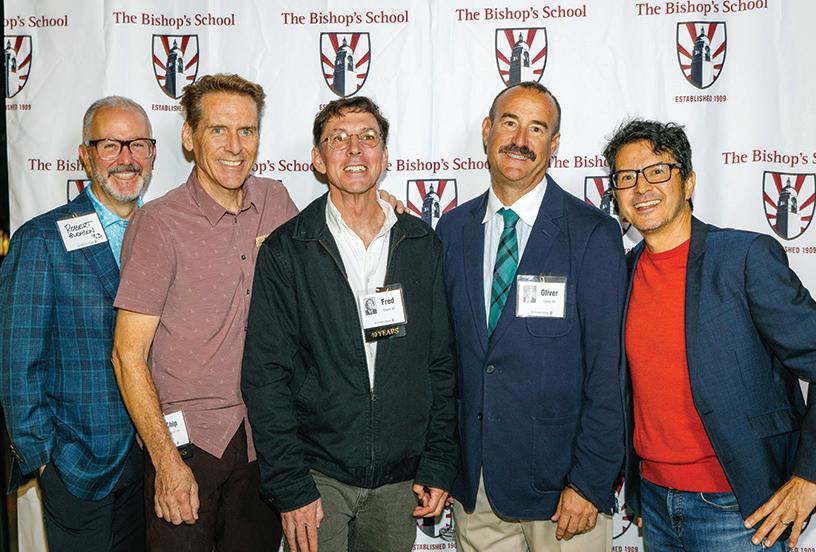


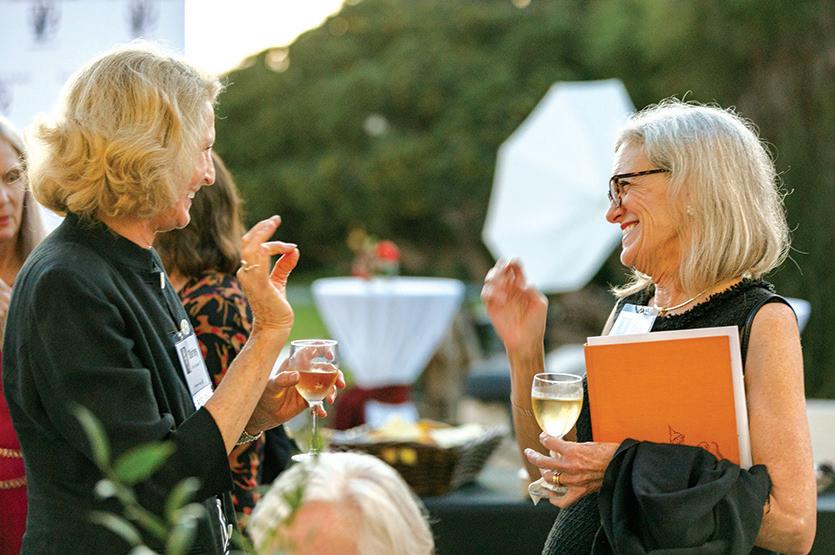
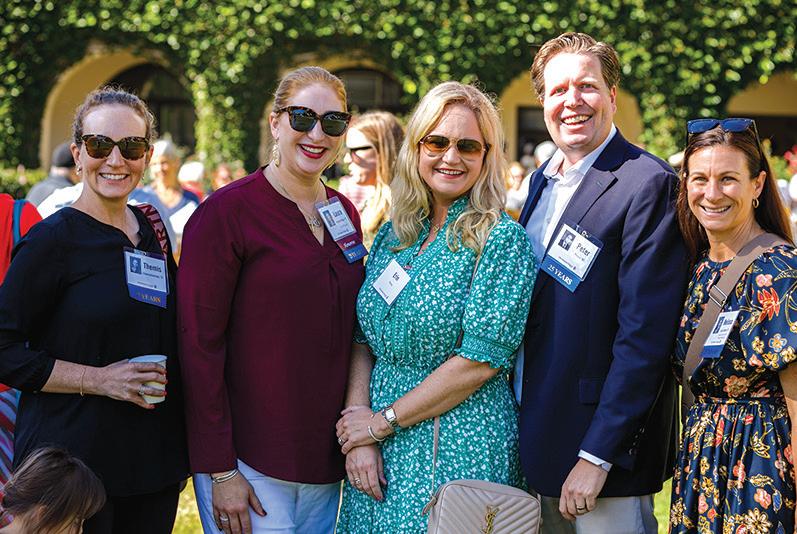
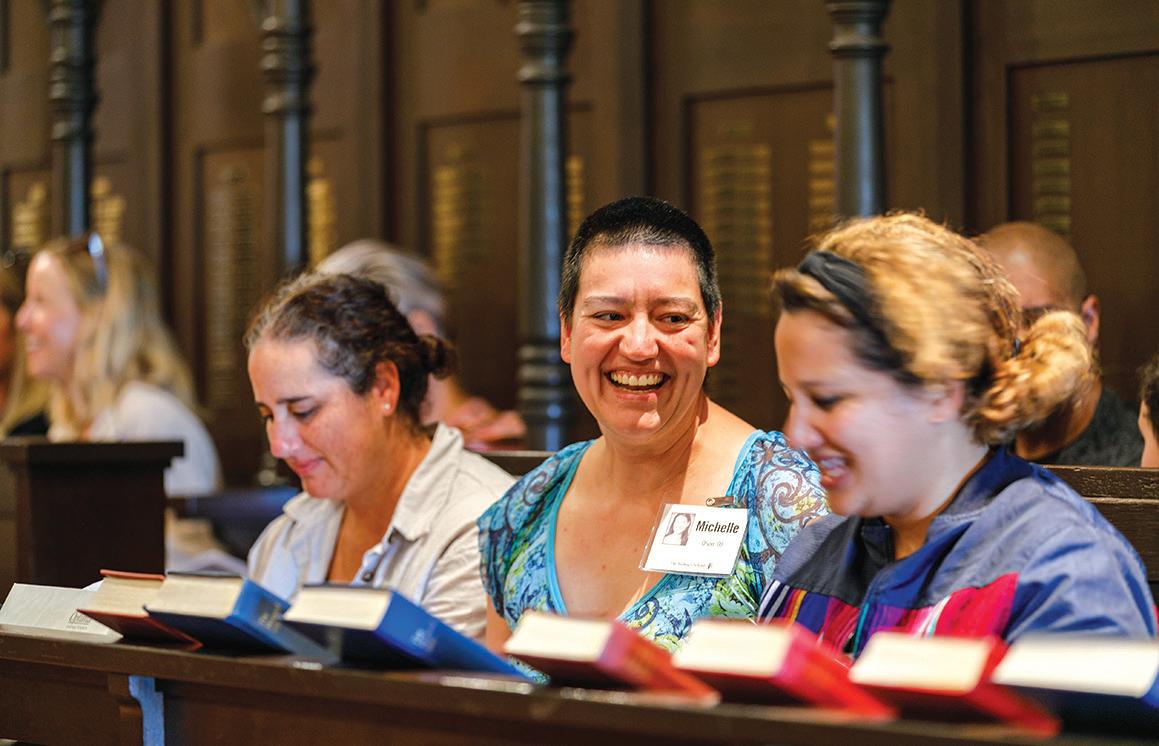
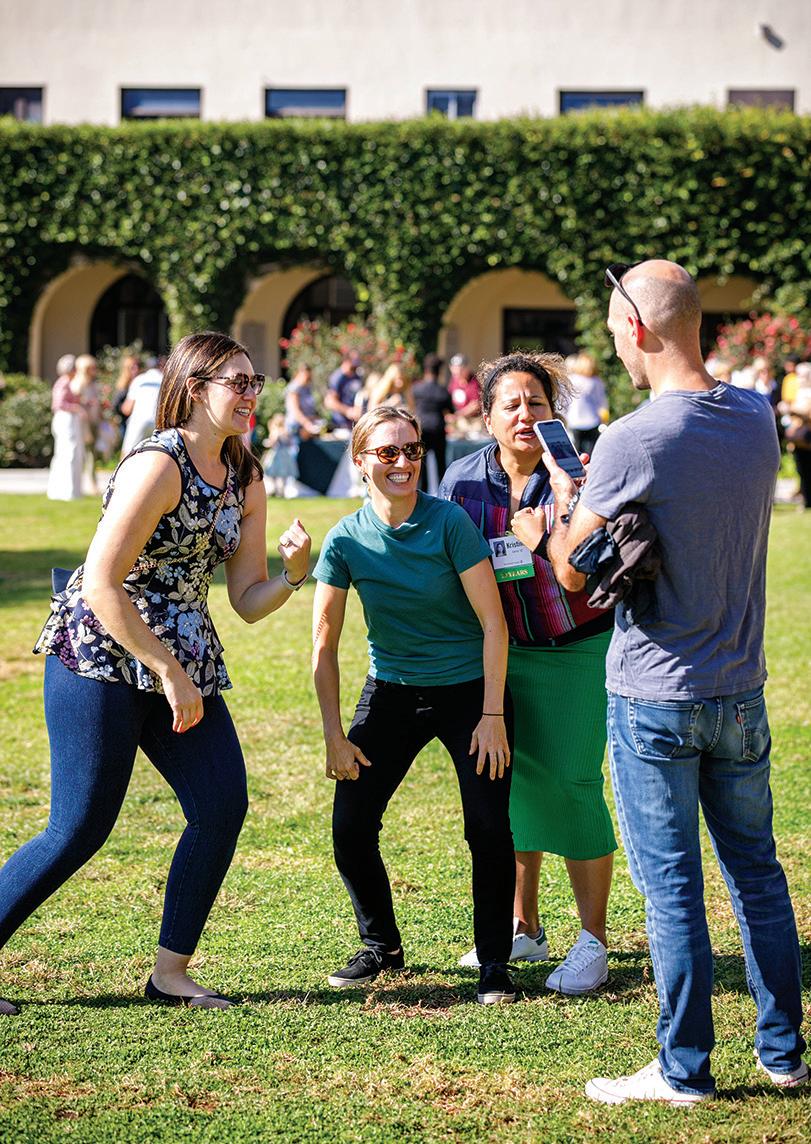
A state of being associated with high life satisfaction, a sense of purpose, and ability to manage life’s ups and downs. It allows one to develop their potential, work productively and creatively, form positive relationships with others and themselves, and contribute meaningfully to society.
At Bishop’s, there are four components to well-being for students:
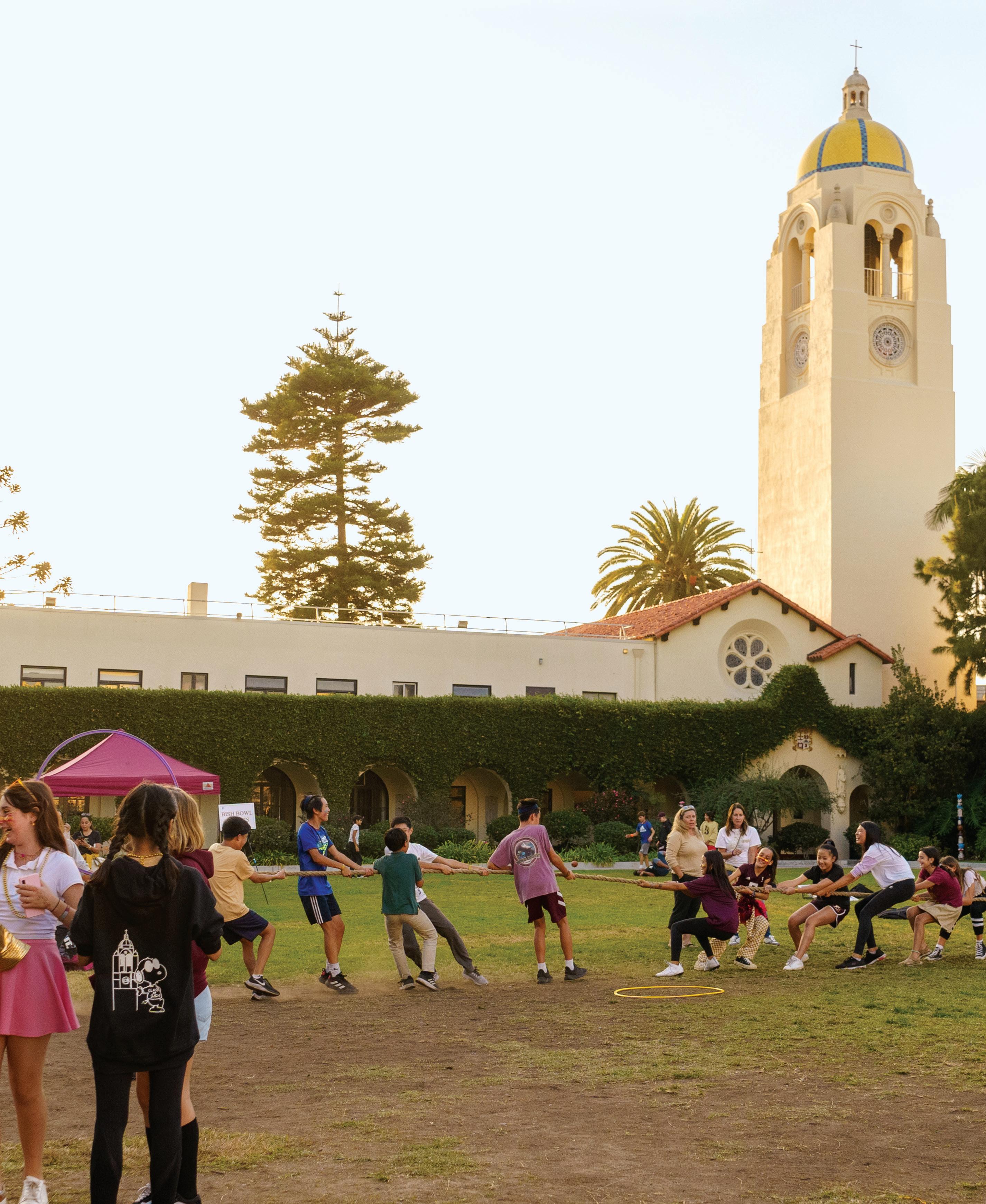
• Emotional stability and satisfaction
• Meaningful relationships and connection
• Physical health and wellness
• Spiritual belief—a connection to something greater than oneself, and that helps guide one’s actions to align with their morals, beliefs and values